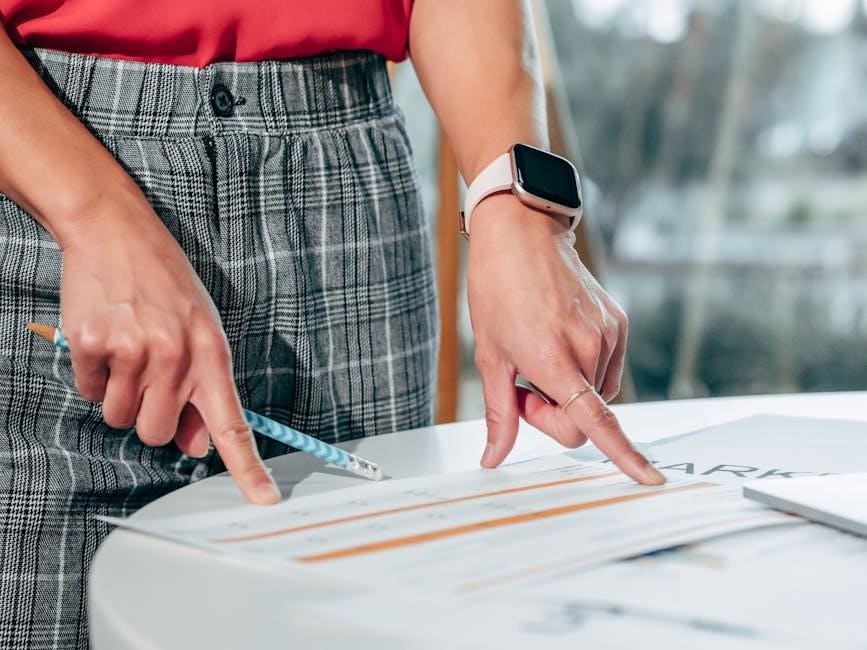Acupressure Points Chart PDF: A Comprehensive Guide
Embark on a journey of holistic wellness with our comprehensive guide to Acupressure Points Charts in PDF format․ These charts serve as invaluable tools for understanding and applying acupressure techniques․ Explore the locations of key points, their corresponding benefits, and how to use them effectively․
Acupressure, an ancient healing art rooted in Traditional Chinese Medicine (TCM), offers a gentle yet powerful approach to wellness․ It operates on the same principles as acupuncture, targeting specific points along meridians to promote energy flow and balance․ Unlike acupuncture, however, acupressure employs finger pressure instead of needles․
This non-invasive technique can be easily learned and practiced at home, empowering individuals to take control of their health․ By stimulating acupoints, you can alleviate pain, reduce stress, improve circulation, and boost your body’s natural healing abilities․ Acupressure addresses a wide range of ailments, from headaches and fatigue to digestive issues and emotional imbalances․
Acupressure charts serve as roadmaps to these potent points, guiding you to their precise locations and therapeutic applications․ These charts are invaluable for both beginners and experienced practitioners․ With a clear understanding of acupressure principles and the aid of a well-designed chart, you can unlock the potential for self-healing and enhanced well-being․ Explore the possibilities of acupressure and discover a natural path to vitality․
Understanding Acupressure and Its Benefits
Acupressure functions on the concept of vital energy, known as Qi (pronounced “chee”), flowing through pathways called meridians․ When Qi becomes blocked or imbalanced, it can manifest as pain, illness, or emotional distress․ Acupressure aims to restore harmony by applying pressure to specific points along these meridians, thereby releasing blockages and promoting smooth energy flow․
The benefits of acupressure are diverse and far-reaching․ It is renowned for its ability to alleviate pain, whether it be headaches, muscle aches, or chronic conditions like arthritis and sciatica․ By stimulating acupoints, acupressure triggers the release of endorphins, natural painkillers that provide relief and promote relaxation․ Furthermore, acupressure can reduce stress and anxiety, improve sleep quality, and boost the immune system․
Regular acupressure practice can enhance overall well-being by promoting physical and emotional balance․ It’s a safe and natural therapy that complements conventional medical treatments․ Understanding the principles of acupressure and its potential benefits empowers you to harness its healing power for yourself and your loved ones․ Acupressure charts are essential for navigating this practice effectively․

Key Acupressure Points and Their Locations
Navigating the world of acupressure begins with understanding key points and their precise locations․ These points, often referred to as acupoints, are specific sites on the body where energy flow can be influenced․ Locating these points accurately is crucial for effective treatment․ Acupressure charts serve as essential guides, providing visual representations and detailed descriptions to pinpoint each acupoint․
One prominent point is Large Intestine 4 (LI4), located on the back of the hand, in the web between the thumb and index finger․ Stimulating LI4 can relieve headaches, toothaches, and neck pain․ Another significant point is Liver 3 (LV3), found on the top of the foot, in the depression between the big toe and second toe․ LV3 is used to alleviate stress, anxiety, and insomnia․ Spleen 6 (SP6), situated on the inner leg, three finger-widths above the ankle bone, addresses digestive issues and menstrual problems․
These are just a few examples of the numerous acupoints that can be utilized for various health concerns․ Accurate location is paramount, and acupressure charts are invaluable tools for both beginners and experienced practitioners․ By mastering the location of these key points, you can unlock the potential of acupressure for self-healing and well-being․
Acupressure Points for Pain Relief
Acupressure offers a natural and effective approach to pain management, targeting specific points to alleviate discomfort․ Acupressure charts serve as vital resources, guiding individuals to the precise locations for pain relief․
For headaches, Large Intestine 4 (LI4), located on the hand between the thumb and index finger, is a primary point․ Applying firm pressure to LI4 can help ease tension headaches and migraines․ Back pain can be addressed with points along the Bladder meridian, found on the back, such as Bladder 23 (BL23), located near the spine at waist level․ Lower back pain often responds well to stimulation of Governing Vessel 4 (GV4), situated on the midline of the lower back․
Neck and shoulder pain can be relieved by targeting points on the Gallbladder meridian, like Gallbladder 20 (GB20), found at the base of the skull in the hollows behind the neck muscles․ For sciatica pain, points along the Bladder meridian on the buttocks and legs, such as Bladder 36 (BL36), can provide relief․ Foot pain can be addressed with Kidney 1 (KI1), located on the sole of the foot․ By using acupressure charts to accurately locate these points, individuals can effectively manage various types of pain․
Acupressure Points for Common Ailments
Acupressure provides a holistic approach to managing various common ailments by stimulating specific points on the body․ Acupressure charts are essential for accurately locating these points․

For digestive issues like indigestion and acid reflux, Pericardium 6 (P6), located on the inner wrist about three finger-widths from the crease, is a key point․ Stimulating P6 can help regulate stomach acid and alleviate nausea․ To address insomnia and promote better sleep, Heart 7 (HT7), found on the wrist crease on the little finger side, is often used․ Applying gentle pressure to HT7 can calm the mind and ease anxiety, leading to improved sleep quality․
For respiratory problems such as flu symptoms, applying pressure to points near the large joints of the fingers can be beneficial․ Lung 7 (LU7), situated on the wrist above the thumb, can help relieve sore throat and cough․ Allergies can be managed by targeting Large Intestine 20 (LI20), located on either side of the nose․ Using acupressure charts ensures precise point location, enhancing the effectiveness of acupressure for these common ailments․
Using Acupressure Charts Effectively
To maximize the benefits of acupressure, understanding how to use acupressure charts is crucial․ These charts provide detailed illustrations and descriptions of acupressure points, guiding you to locate them accurately․ When using a chart, start by identifying the specific area of the body you want to treat․ Then, carefully examine the chart to pinpoint the corresponding acupressure points․

Ensure you are in a comfortable and relaxed environment before beginning․ Use your fingers, thumbs, or a specialized acupressure tool to apply gentle but firm pressure to the identified point․ Maintain the pressure for about 30 seconds to a few minutes, using circular motions to stimulate the area․
Pay attention to your body’s response and adjust the pressure accordingly․ It’s essential to cross-reference multiple charts and resources to confirm the point’s location, especially when starting․ Proper breathing techniques can also enhance the effectiveness of the treatment․ By following these steps, you can effectively use acupressure charts to promote wellness and manage various health conditions․
Free Acupressure Chart PDF Downloads
Accessing high-quality acupressure charts doesn’t have to break the bank․ Numerous resources offer free acupressure chart PDF downloads, providing valuable tools for exploring this ancient healing practice․ These charts are often available from reputable websites dedicated to traditional Chinese medicine, acupuncture, and holistic health․ When searching for free charts, prioritize those from trusted sources to ensure accuracy and reliability․
Many of these downloadable charts include detailed diagrams and descriptions of key acupressure points, their locations, and the conditions they can help alleviate․ Some charts are designed for specific purposes, such as pain relief or managing common ailments like headaches and nausea․ Be sure to choose charts that align with your particular needs and interests․
Before using any free acupressure chart, take the time to verify the information against other resources․ Remember that these charts are intended as a guide and should not replace professional medical advice․ With careful research and responsible use, free acupressure chart PDFs can be a fantastic starting point for your acupressure journey․
Acupressure for Specific Conditions: Sciatica
Sciatica, characterized by pain radiating along the sciatic nerve, can significantly impact daily life․ Acupressure offers a non-invasive approach to managing sciatica symptoms by targeting specific points along the affected nerve pathways․ Applying pressure to these points can help release tension, reduce inflammation, and alleviate pain associated with sciatica․
Several acupressure points are commonly used for sciatica relief․ These points often correspond to areas where the sciatic nerve is compressed or irritated․ For example, points located in the lower back, buttocks, and along the back of the leg are frequently targeted․ The Bladder meridian, which runs along the back, is particularly relevant in addressing sciatica pain․
When using acupressure for sciatica, it’s essential to apply firm but gentle pressure to the selected points․ Maintain the pressure for several minutes, focusing on deep, even breathing․ It’s also crucial to consult with a qualified acupuncturist or healthcare professional for personalized guidance and to ensure that acupressure is appropriate for your specific condition․
Acupressure for Flu Symptoms
Acupressure can be a valuable complementary therapy for alleviating flu symptoms․ By stimulating specific points, you can potentially boost your immune system, reduce fever, relieve sore throat, and ease congestion․ While not a replacement for medical treatment, acupressure can offer comfort and support during a bout of the flu․
Several key acupressure points are beneficial for managing flu symptoms․ One such point is located on the inside of the elbow crease, which may help with fever and sore throat․ Other effective points can be found on the hands, specifically at the seams of the finger joints, where applying pressure may aid in reducing fever and congestion․
To use acupressure for flu relief, apply gentle but firm pressure to the selected points for a few minutes at a time․ Focus on deep, regular breathing while applying pressure․ Remember to stay hydrated and rest adequately to support your body’s natural healing processes․ Consult with a healthcare professional for comprehensive flu management․
Acupuncture Points and Meridian Chart
Acupuncture points and meridian charts are essential tools for understanding the flow of energy within the body according to Traditional Chinese Medicine (TCM)․ These charts illustrate the locations of hundreds of acupuncture points along specific pathways known as meridians․ Each point corresponds to particular organs and functions, influencing overall health and well-being․
Meridians are invisible channels through which vital energy, or Qi, circulates․ When Qi becomes blocked or imbalanced, it can lead to various health issues․ Acupuncture and acupressure aim to restore the harmonious flow of Qi by stimulating specific points along these meridians․
An acupuncture points and meridian chart typically depicts the body with lines representing the meridians and labeled points indicating the precise locations for treatment․ These charts often include both traditional Chinese names and Western anatomical references for each point․ Studying these charts can provide valuable insights into the interconnectedness of the body and the principles of TCM․
Acupressure vs․ Acupuncture
Acupressure and acupuncture, both rooted in Traditional Chinese Medicine (TCM), share the same fundamental principle of stimulating specific points on the body to promote healing․ However, they differ significantly in their method of application․ Acupuncture involves the insertion of thin needles into these points by a trained practitioner, whereas acupressure utilizes the gentle application of finger or hand pressure to achieve similar effects․
Acupressure is a non-invasive technique that can be self-administered or performed by a massage therapist․ It is often used for self-care, pain management, and stress reduction․ Acupuncture, on the other hand, requires the expertise of a licensed acupuncturist who can accurately diagnose imbalances and select the appropriate points for treatment․
Both acupressure and acupuncture are believed to influence the flow of Qi (vital energy) along meridians, promoting balance and restoring health․ While acupressure may be more accessible for at-home use, acupuncture offers a more precise and potentially more potent therapeutic approach under professional guidance․
Resources for Further Learning
To deepen your understanding of acupressure, numerous resources are available for continued learning․ Books offer in-depth knowledge of acupressure points, meridians, and techniques․ Look for titles that include detailed charts, illustrations, and practical guidance․ Online courses and workshops provide interactive learning experiences, often taught by certified acupressure practitioners․
Websites dedicated to Traditional Chinese Medicine (TCM) offer a wealth of information on acupressure, acupuncture, and related therapies․ These resources may include articles, videos, and forums where you can connect with other enthusiasts․ Consider exploring professional organizations that offer certification programs and continuing education for acupressure therapists․

For those interested in feline acupressure, resources specifically tailored to cats are available, including charts developed for veterinarians․ Remember to consult with a healthcare professional or certified acupressure practitioner before starting any new treatment, and always prioritize safety and proper technique․

